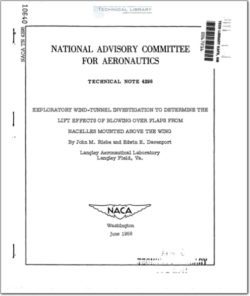NACA-TN-4298

- Version
- 210 Downloads
- 839.23 KB File Size
- 1 File Count
- December 4, 2015 Create Date
- December 4, 2015 Last Updated
National Advisory Committee for Aeronautics, Technical Notes - Wind Tunnel Investigation to Determine the Lift Effect of Blowing over Flaps from Nacelles Mounted Above the Wing

An exploratory wind-tunnel investigation has been made to determine
the lift effects of blowing from nacelles over the upper surface of flaps
on a model having a delta wing of aspect ratio 5. Several flap conditions
were examined. High-pressure air was blown from an external-pipe arrange-
ment supported above the wing to simulate Jet-engine exhaust. The Jet—
momengum-coefficient range was from O to 5.0 and the model angle of attack
was 0.
The results of this limited investigation show that values of Jet-
circulation lift coefficient larger than the jet reaction were produced
with blowing over flaps from nacelles mounted above the wing. The use of
double slotted flaps with the gap unsealed between the flaps and wing had
a large detrimental effect on the lift capabilities. With these gaps
sealed, larger lift coefficients were obtained when fantails were added
to the nacelles. The longitudinal trim problems created by large diving
moments were similar to those encountered with other jet-augmented-flap
systems.
Previous investigations have shown that jet-augmented flaps show
promise in reducing the take-off and landing distance of Jet aircraft.
(For example, see refs. 1, 2, and 5.) This work can be divided into two
general catagories: an external arrangement in which the exhaust air
from engines mounted below the wing is directed up through a slot and
downward over the upper surface of the flaps, and an internal arrangement
in which Jet engines are blended with the wing with the air brought in the
wing leading edge and exhausted at the trailing edge. An arrangement with
blowing over flaps from nacelles mounted on top of or above the wing might
achieve most of the advantages of the multiple-internal-engine arrange—
ment but with a relatively small number of externally mounted engines.
Possible advantages of such an arrangement on a high-wing airplane are:
noise suppression benefiting both the occupants and the people on the
ground, good slow-speed performance, diminution_of ground effect, and
reduction of trash ingestion by high placement of the engine inlets. The
arrangement would be especially suited for seaplanes because it would
reduce the spray on the engine inlets and on the flaps.
| File | Action |
|---|---|
| naca-tn-4298.pdf | Download |

Comment On This Post